Analysing Organisational Capacity and Structure in Healthcare: WMH
VerifiedAdded on 2021/04/19
|11
|2282
|36
Essay
AI Summary
This essay delves into the critical aspects of building organisational capacity within the healthcare sector, using the case of Sydney's Whitlam Memorial Hospital (WMH) as a focal point. It begins by emphasizing the importance of capacity building in healthcare, driven by informed consumers demanding high-quality services. The essay explores the limitations of WMH's current bureaucratic structure and its impact on achieving the hospital's mission, vision, and objectives. It then proposes the matrix organisational structure, combined with a service line approach, as a more suitable alternative. The analysis highlights the strengths of the matrix model, such as improved internal communication and adaptability to changing consumer needs. The essay also acknowledges the limitations of the matrix model, including its cost and complexity. The essay concludes that WMH can achieve its goals by adopting a matrix structure aligned with a service line approach, enhancing collaborative and communicative environments to meet community needs effectively. The essay references several academic sources to support its arguments.
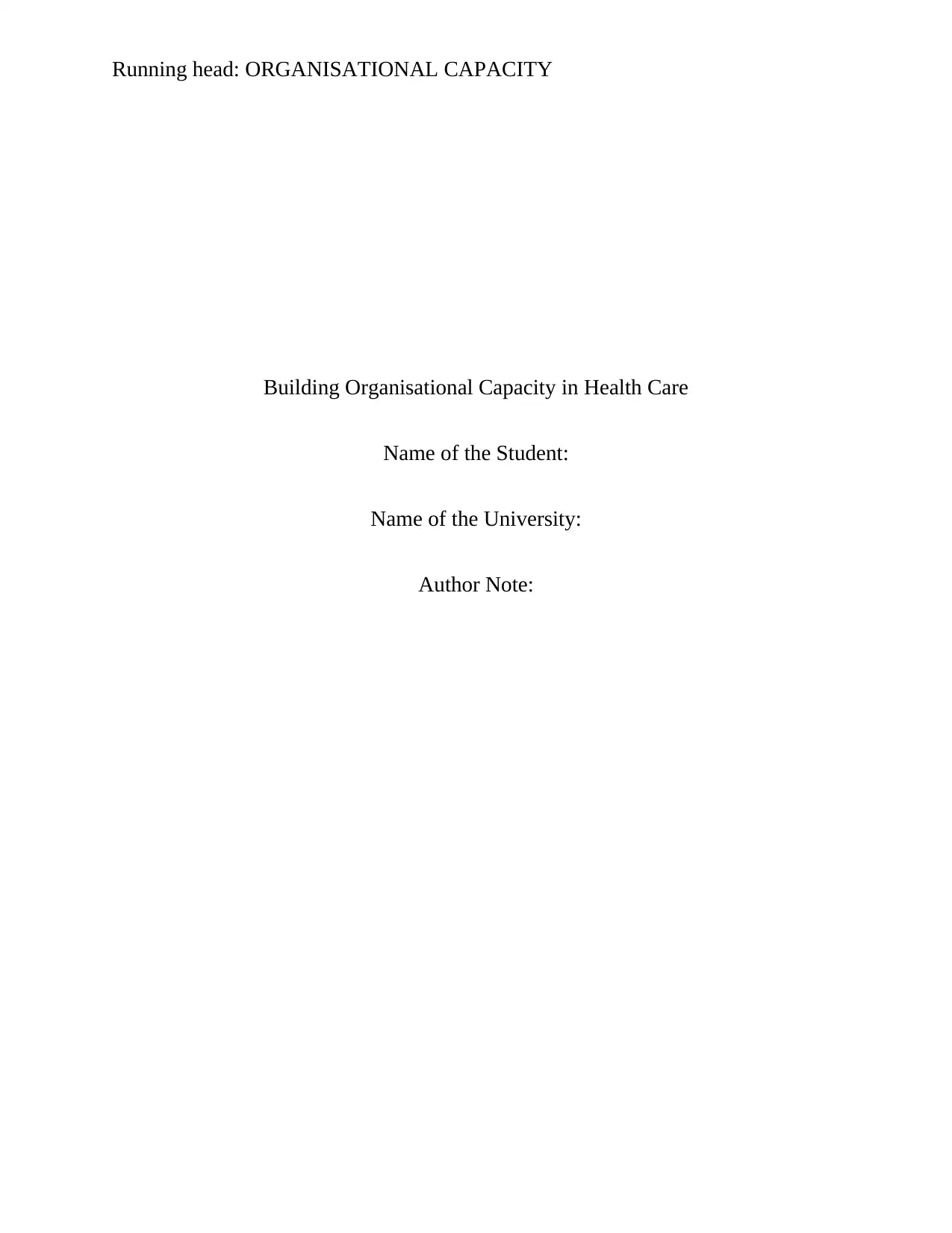
Running head: ORGANISATIONAL CAPACITY
Building Organisational Capacity in Health Care
Name of the Student:
Name of the University:
Author Note:
Building Organisational Capacity in Health Care
Name of the Student:
Name of the University:
Author Note:
Paraphrase This Document
Need a fresh take? Get an instant paraphrase of this document with our AI Paraphraser
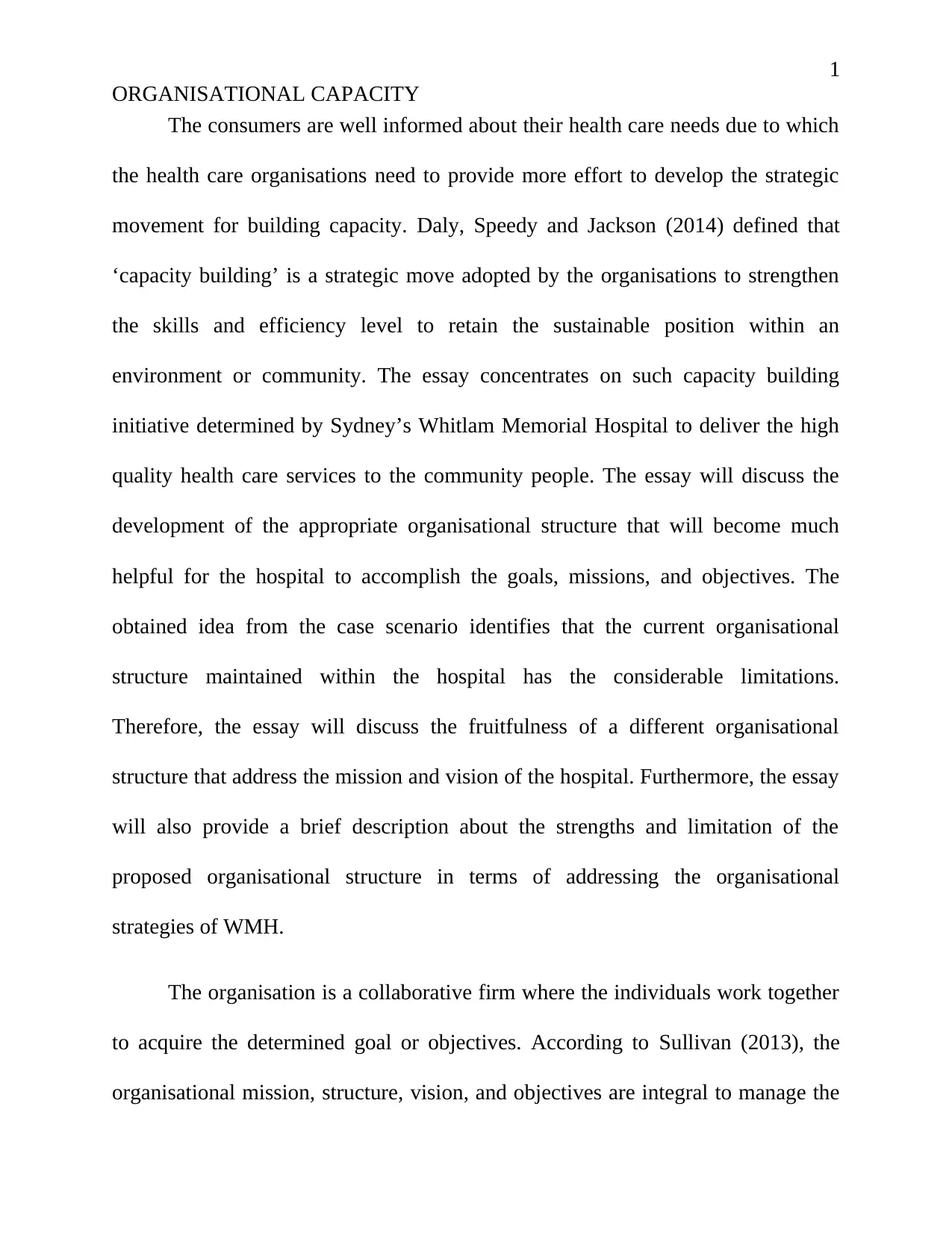
1
ORGANISATIONAL CAPACITY
The consumers are well informed about their health care needs due to which
the health care organisations need to provide more effort to develop the strategic
movement for building capacity. Daly, Speedy and Jackson (2014) defined that
‘capacity building’ is a strategic move adopted by the organisations to strengthen
the skills and efficiency level to retain the sustainable position within an
environment or community. The essay concentrates on such capacity building
initiative determined by Sydney’s Whitlam Memorial Hospital to deliver the high
quality health care services to the community people. The essay will discuss the
development of the appropriate organisational structure that will become much
helpful for the hospital to accomplish the goals, missions, and objectives. The
obtained idea from the case scenario identifies that the current organisational
structure maintained within the hospital has the considerable limitations.
Therefore, the essay will discuss the fruitfulness of a different organisational
structure that address the mission and vision of the hospital. Furthermore, the essay
will also provide a brief description about the strengths and limitation of the
proposed organisational structure in terms of addressing the organisational
strategies of WMH.
The organisation is a collaborative firm where the individuals work together
to acquire the determined goal or objectives. According to Sullivan (2013), the
organisational mission, structure, vision, and objectives are integral to manage the
ORGANISATIONAL CAPACITY
The consumers are well informed about their health care needs due to which
the health care organisations need to provide more effort to develop the strategic
movement for building capacity. Daly, Speedy and Jackson (2014) defined that
‘capacity building’ is a strategic move adopted by the organisations to strengthen
the skills and efficiency level to retain the sustainable position within an
environment or community. The essay concentrates on such capacity building
initiative determined by Sydney’s Whitlam Memorial Hospital to deliver the high
quality health care services to the community people. The essay will discuss the
development of the appropriate organisational structure that will become much
helpful for the hospital to accomplish the goals, missions, and objectives. The
obtained idea from the case scenario identifies that the current organisational
structure maintained within the hospital has the considerable limitations.
Therefore, the essay will discuss the fruitfulness of a different organisational
structure that address the mission and vision of the hospital. Furthermore, the essay
will also provide a brief description about the strengths and limitation of the
proposed organisational structure in terms of addressing the organisational
strategies of WMH.
The organisation is a collaborative firm where the individuals work together
to acquire the determined goal or objectives. According to Sullivan (2013), the
organisational mission, structure, vision, and objectives are integral to manage the
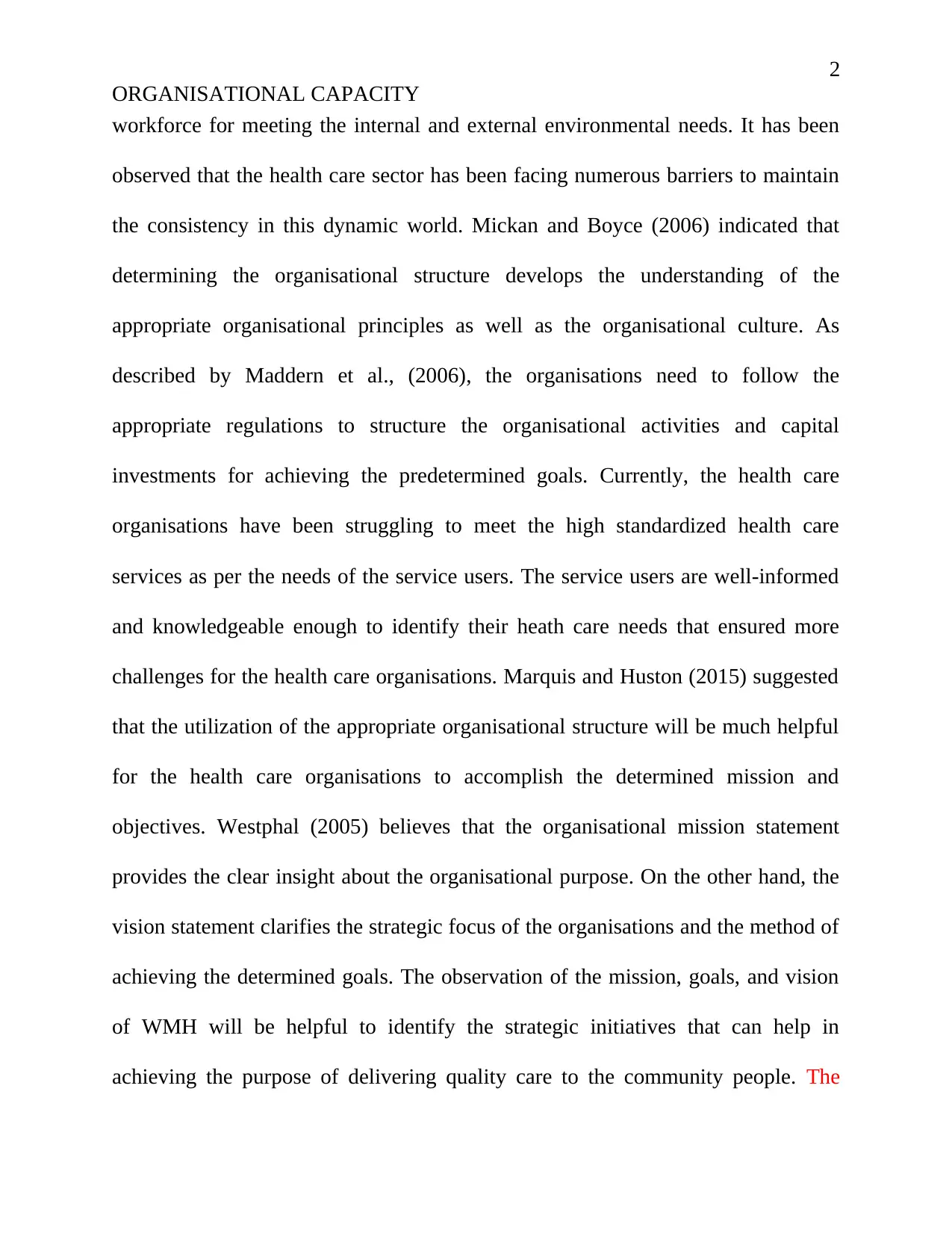
2
ORGANISATIONAL CAPACITY
workforce for meeting the internal and external environmental needs. It has been
observed that the health care sector has been facing numerous barriers to maintain
the consistency in this dynamic world. Mickan and Boyce (2006) indicated that
determining the organisational structure develops the understanding of the
appropriate organisational principles as well as the organisational culture. As
described by Maddern et al., (2006), the organisations need to follow the
appropriate regulations to structure the organisational activities and capital
investments for achieving the predetermined goals. Currently, the health care
organisations have been struggling to meet the high standardized health care
services as per the needs of the service users. The service users are well-informed
and knowledgeable enough to identify their heath care needs that ensured more
challenges for the health care organisations. Marquis and Huston (2015) suggested
that the utilization of the appropriate organisational structure will be much helpful
for the health care organisations to accomplish the determined mission and
objectives. Westphal (2005) believes that the organisational mission statement
provides the clear insight about the organisational purpose. On the other hand, the
vision statement clarifies the strategic focus of the organisations and the method of
achieving the determined goals. The observation of the mission, goals, and vision
of WMH will be helpful to identify the strategic initiatives that can help in
achieving the purpose of delivering quality care to the community people. The
ORGANISATIONAL CAPACITY
workforce for meeting the internal and external environmental needs. It has been
observed that the health care sector has been facing numerous barriers to maintain
the consistency in this dynamic world. Mickan and Boyce (2006) indicated that
determining the organisational structure develops the understanding of the
appropriate organisational principles as well as the organisational culture. As
described by Maddern et al., (2006), the organisations need to follow the
appropriate regulations to structure the organisational activities and capital
investments for achieving the predetermined goals. Currently, the health care
organisations have been struggling to meet the high standardized health care
services as per the needs of the service users. The service users are well-informed
and knowledgeable enough to identify their heath care needs that ensured more
challenges for the health care organisations. Marquis and Huston (2015) suggested
that the utilization of the appropriate organisational structure will be much helpful
for the health care organisations to accomplish the determined mission and
objectives. Westphal (2005) believes that the organisational mission statement
provides the clear insight about the organisational purpose. On the other hand, the
vision statement clarifies the strategic focus of the organisations and the method of
achieving the determined goals. The observation of the mission, goals, and vision
of WMH will be helpful to identify the strategic initiatives that can help in
achieving the purpose of delivering quality care to the community people. The
⊘ This is a preview!⊘
Do you want full access?
Subscribe today to unlock all pages.

Trusted by 1+ million students worldwide
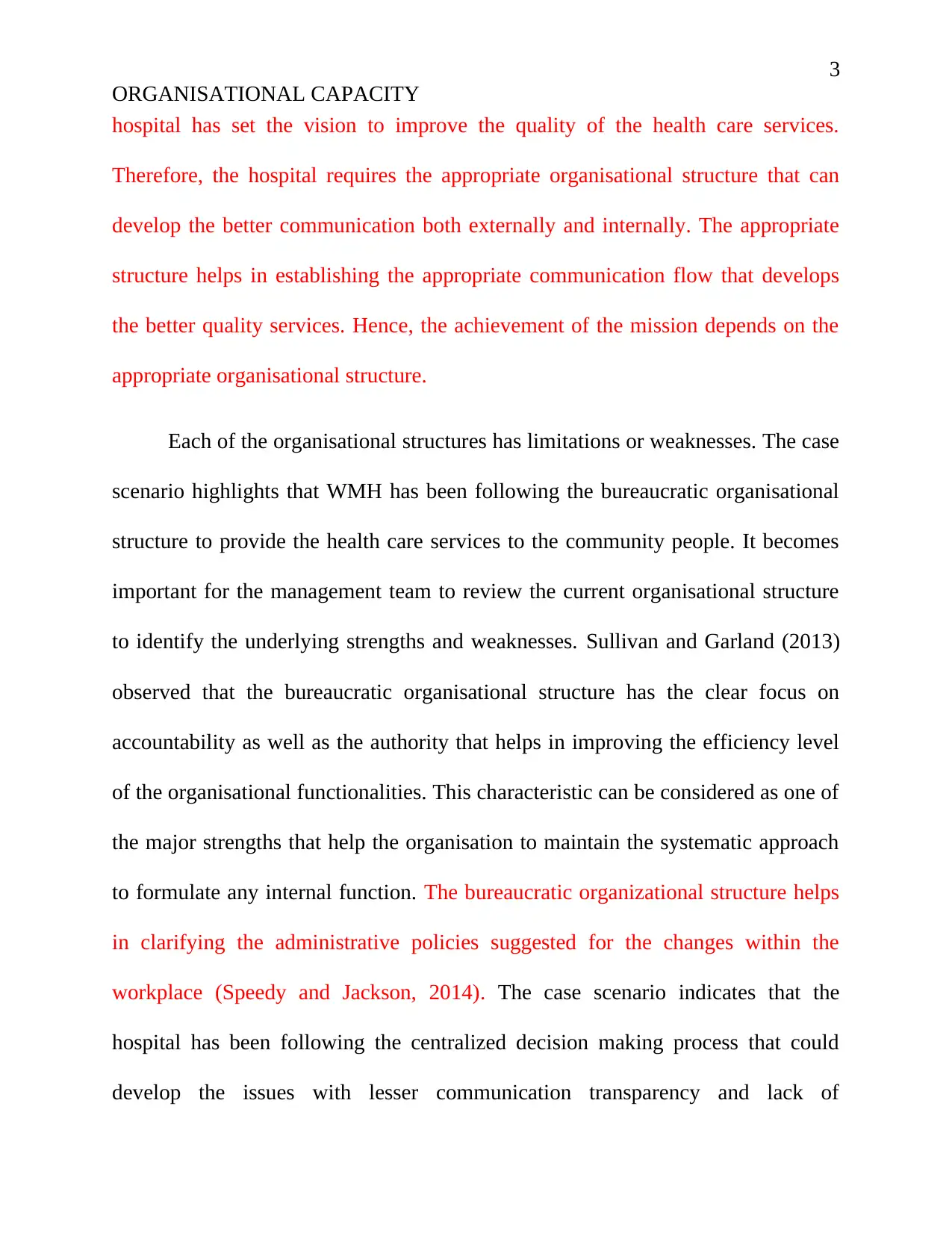
3
ORGANISATIONAL CAPACITY
hospital has set the vision to improve the quality of the health care services.
Therefore, the hospital requires the appropriate organisational structure that can
develop the better communication both externally and internally. The appropriate
structure helps in establishing the appropriate communication flow that develops
the better quality services. Hence, the achievement of the mission depends on the
appropriate organisational structure.
Each of the organisational structures has limitations or weaknesses. The case
scenario highlights that WMH has been following the bureaucratic organisational
structure to provide the health care services to the community people. It becomes
important for the management team to review the current organisational structure
to identify the underlying strengths and weaknesses. Sullivan and Garland (2013)
observed that the bureaucratic organisational structure has the clear focus on
accountability as well as the authority that helps in improving the efficiency level
of the organisational functionalities. This characteristic can be considered as one of
the major strengths that help the organisation to maintain the systematic approach
to formulate any internal function. The bureaucratic organizational structure helps
in clarifying the administrative policies suggested for the changes within the
workplace (Speedy and Jackson, 2014). The case scenario indicates that the
hospital has been following the centralized decision making process that could
develop the issues with lesser communication transparency and lack of
ORGANISATIONAL CAPACITY
hospital has set the vision to improve the quality of the health care services.
Therefore, the hospital requires the appropriate organisational structure that can
develop the better communication both externally and internally. The appropriate
structure helps in establishing the appropriate communication flow that develops
the better quality services. Hence, the achievement of the mission depends on the
appropriate organisational structure.
Each of the organisational structures has limitations or weaknesses. The case
scenario highlights that WMH has been following the bureaucratic organisational
structure to provide the health care services to the community people. It becomes
important for the management team to review the current organisational structure
to identify the underlying strengths and weaknesses. Sullivan and Garland (2013)
observed that the bureaucratic organisational structure has the clear focus on
accountability as well as the authority that helps in improving the efficiency level
of the organisational functionalities. This characteristic can be considered as one of
the major strengths that help the organisation to maintain the systematic approach
to formulate any internal function. The bureaucratic organizational structure helps
in clarifying the administrative policies suggested for the changes within the
workplace (Speedy and Jackson, 2014). The case scenario indicates that the
hospital has been following the centralized decision making process that could
develop the issues with lesser communication transparency and lack of
Paraphrase This Document
Need a fresh take? Get an instant paraphrase of this document with our AI Paraphraser
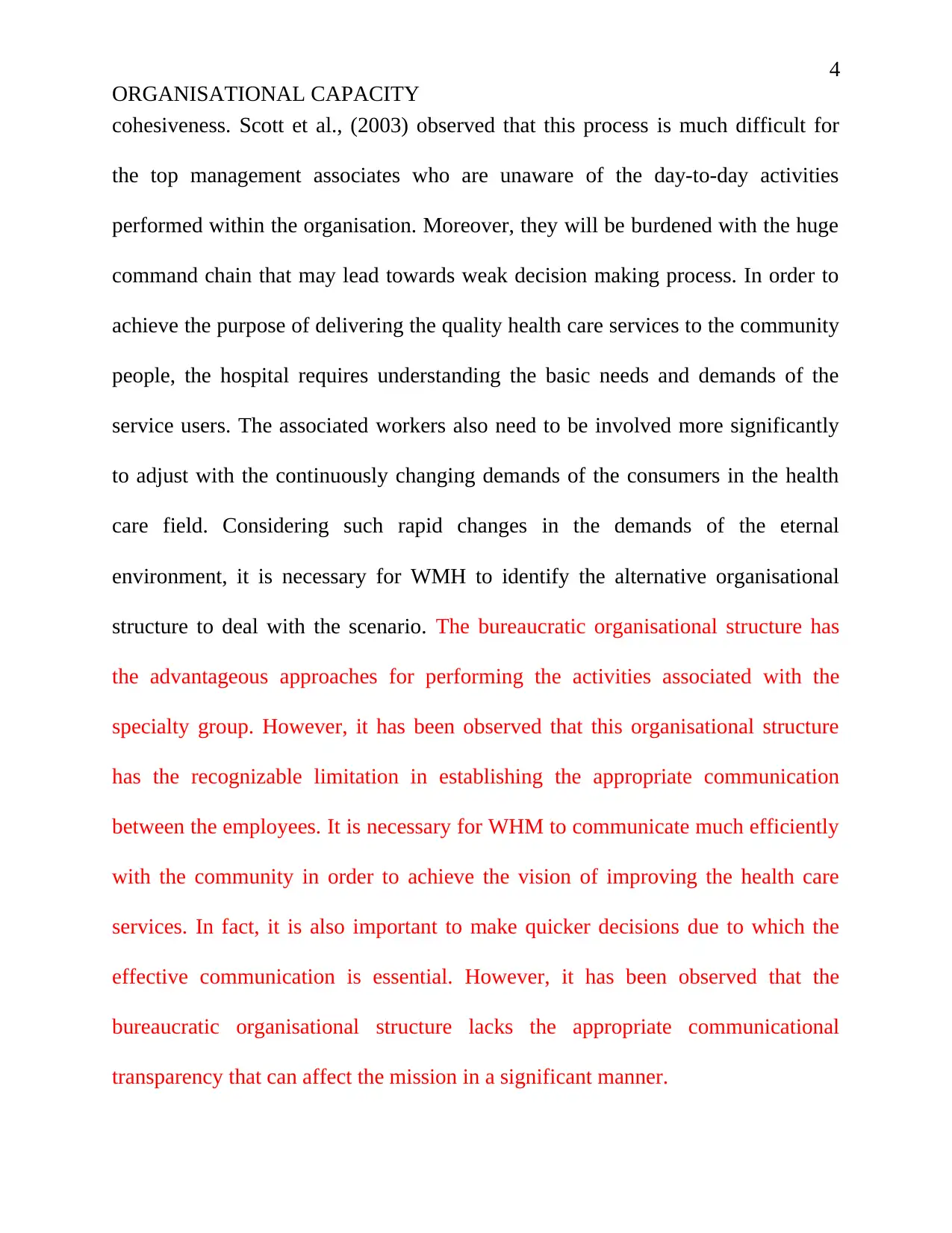
4
ORGANISATIONAL CAPACITY
cohesiveness. Scott et al., (2003) observed that this process is much difficult for
the top management associates who are unaware of the day-to-day activities
performed within the organisation. Moreover, they will be burdened with the huge
command chain that may lead towards weak decision making process. In order to
achieve the purpose of delivering the quality health care services to the community
people, the hospital requires understanding the basic needs and demands of the
service users. The associated workers also need to be involved more significantly
to adjust with the continuously changing demands of the consumers in the health
care field. Considering such rapid changes in the demands of the eternal
environment, it is necessary for WMH to identify the alternative organisational
structure to deal with the scenario. The bureaucratic organisational structure has
the advantageous approaches for performing the activities associated with the
specialty group. However, it has been observed that this organisational structure
has the recognizable limitation in establishing the appropriate communication
between the employees. It is necessary for WHM to communicate much efficiently
with the community in order to achieve the vision of improving the health care
services. In fact, it is also important to make quicker decisions due to which the
effective communication is essential. However, it has been observed that the
bureaucratic organisational structure lacks the appropriate communicational
transparency that can affect the mission in a significant manner.
ORGANISATIONAL CAPACITY
cohesiveness. Scott et al., (2003) observed that this process is much difficult for
the top management associates who are unaware of the day-to-day activities
performed within the organisation. Moreover, they will be burdened with the huge
command chain that may lead towards weak decision making process. In order to
achieve the purpose of delivering the quality health care services to the community
people, the hospital requires understanding the basic needs and demands of the
service users. The associated workers also need to be involved more significantly
to adjust with the continuously changing demands of the consumers in the health
care field. Considering such rapid changes in the demands of the eternal
environment, it is necessary for WMH to identify the alternative organisational
structure to deal with the scenario. The bureaucratic organisational structure has
the advantageous approaches for performing the activities associated with the
specialty group. However, it has been observed that this organisational structure
has the recognizable limitation in establishing the appropriate communication
between the employees. It is necessary for WHM to communicate much efficiently
with the community in order to achieve the vision of improving the health care
services. In fact, it is also important to make quicker decisions due to which the
effective communication is essential. However, it has been observed that the
bureaucratic organisational structure lacks the appropriate communicational
transparency that can affect the mission in a significant manner.
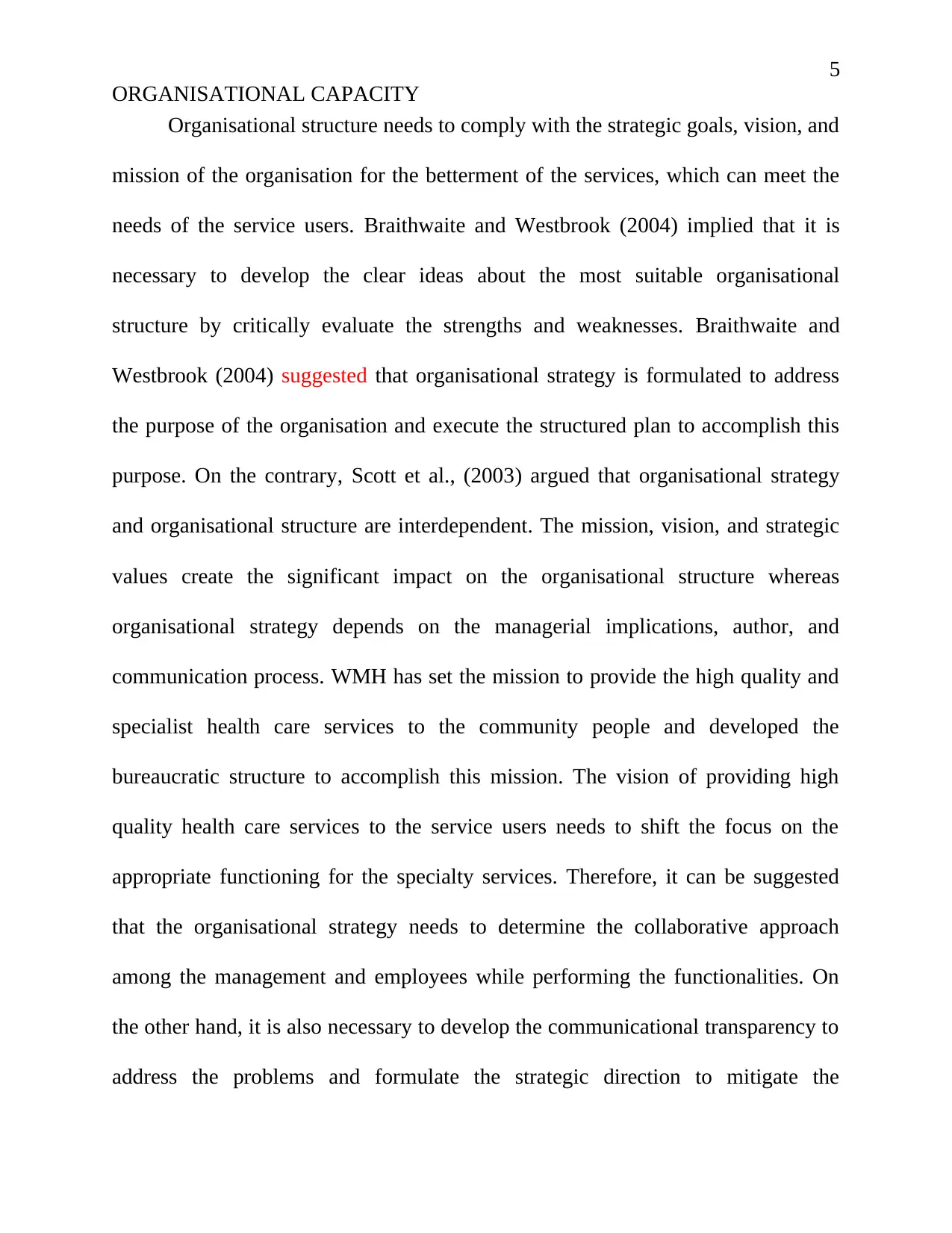
5
ORGANISATIONAL CAPACITY
Organisational structure needs to comply with the strategic goals, vision, and
mission of the organisation for the betterment of the services, which can meet the
needs of the service users. Braithwaite and Westbrook (2004) implied that it is
necessary to develop the clear ideas about the most suitable organisational
structure by critically evaluate the strengths and weaknesses. Braithwaite and
Westbrook (2004) suggested that organisational strategy is formulated to address
the purpose of the organisation and execute the structured plan to accomplish this
purpose. On the contrary, Scott et al., (2003) argued that organisational strategy
and organisational structure are interdependent. The mission, vision, and strategic
values create the significant impact on the organisational structure whereas
organisational strategy depends on the managerial implications, author, and
communication process. WMH has set the mission to provide the high quality and
specialist health care services to the community people and developed the
bureaucratic structure to accomplish this mission. The vision of providing high
quality health care services to the service users needs to shift the focus on the
appropriate functioning for the specialty services. Therefore, it can be suggested
that the organisational strategy needs to determine the collaborative approach
among the management and employees while performing the functionalities. On
the other hand, it is also necessary to develop the communicational transparency to
address the problems and formulate the strategic direction to mitigate the
ORGANISATIONAL CAPACITY
Organisational structure needs to comply with the strategic goals, vision, and
mission of the organisation for the betterment of the services, which can meet the
needs of the service users. Braithwaite and Westbrook (2004) implied that it is
necessary to develop the clear ideas about the most suitable organisational
structure by critically evaluate the strengths and weaknesses. Braithwaite and
Westbrook (2004) suggested that organisational strategy is formulated to address
the purpose of the organisation and execute the structured plan to accomplish this
purpose. On the contrary, Scott et al., (2003) argued that organisational strategy
and organisational structure are interdependent. The mission, vision, and strategic
values create the significant impact on the organisational structure whereas
organisational strategy depends on the managerial implications, author, and
communication process. WMH has set the mission to provide the high quality and
specialist health care services to the community people and developed the
bureaucratic structure to accomplish this mission. The vision of providing high
quality health care services to the service users needs to shift the focus on the
appropriate functioning for the specialty services. Therefore, it can be suggested
that the organisational strategy needs to determine the collaborative approach
among the management and employees while performing the functionalities. On
the other hand, it is also necessary to develop the communicational transparency to
address the problems and formulate the strategic direction to mitigate the
⊘ This is a preview!⊘
Do you want full access?
Subscribe today to unlock all pages.

Trusted by 1+ million students worldwide
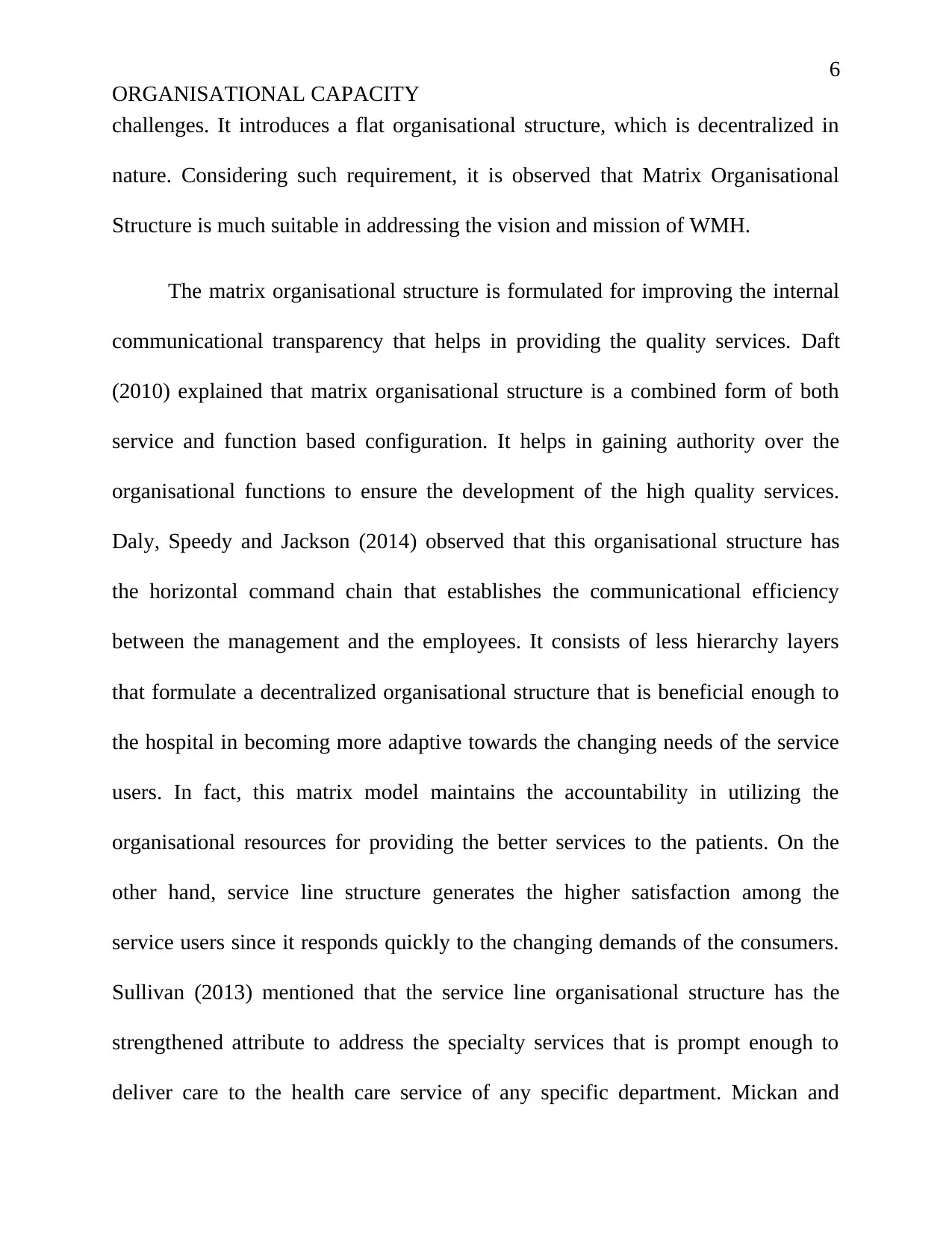
6
ORGANISATIONAL CAPACITY
challenges. It introduces a flat organisational structure, which is decentralized in
nature. Considering such requirement, it is observed that Matrix Organisational
Structure is much suitable in addressing the vision and mission of WMH.
The matrix organisational structure is formulated for improving the internal
communicational transparency that helps in providing the quality services. Daft
(2010) explained that matrix organisational structure is a combined form of both
service and function based configuration. It helps in gaining authority over the
organisational functions to ensure the development of the high quality services.
Daly, Speedy and Jackson (2014) observed that this organisational structure has
the horizontal command chain that establishes the communicational efficiency
between the management and the employees. It consists of less hierarchy layers
that formulate a decentralized organisational structure that is beneficial enough to
the hospital in becoming more adaptive towards the changing needs of the service
users. In fact, this matrix model maintains the accountability in utilizing the
organisational resources for providing the better services to the patients. On the
other hand, service line structure generates the higher satisfaction among the
service users since it responds quickly to the changing demands of the consumers.
Sullivan (2013) mentioned that the service line organisational structure has the
strengthened attribute to address the specialty services that is prompt enough to
deliver care to the health care service of any specific department. Mickan and
ORGANISATIONAL CAPACITY
challenges. It introduces a flat organisational structure, which is decentralized in
nature. Considering such requirement, it is observed that Matrix Organisational
Structure is much suitable in addressing the vision and mission of WMH.
The matrix organisational structure is formulated for improving the internal
communicational transparency that helps in providing the quality services. Daft
(2010) explained that matrix organisational structure is a combined form of both
service and function based configuration. It helps in gaining authority over the
organisational functions to ensure the development of the high quality services.
Daly, Speedy and Jackson (2014) observed that this organisational structure has
the horizontal command chain that establishes the communicational efficiency
between the management and the employees. It consists of less hierarchy layers
that formulate a decentralized organisational structure that is beneficial enough to
the hospital in becoming more adaptive towards the changing needs of the service
users. In fact, this matrix model maintains the accountability in utilizing the
organisational resources for providing the better services to the patients. On the
other hand, service line structure generates the higher satisfaction among the
service users since it responds quickly to the changing demands of the consumers.
Sullivan (2013) mentioned that the service line organisational structure has the
strengthened attribute to address the specialty services that is prompt enough to
deliver care to the health care service of any specific department. Mickan and
Paraphrase This Document
Need a fresh take? Get an instant paraphrase of this document with our AI Paraphraser
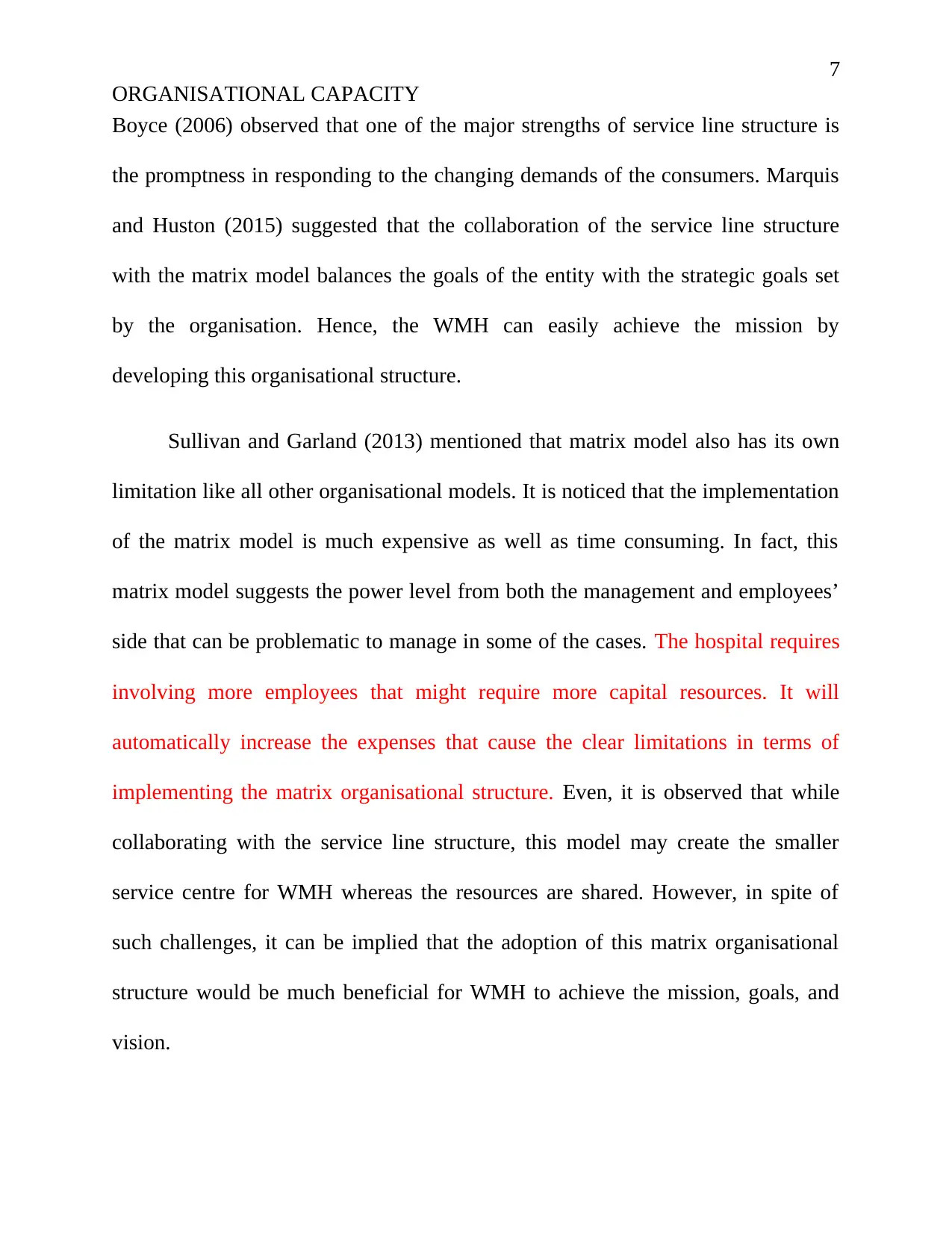
7
ORGANISATIONAL CAPACITY
Boyce (2006) observed that one of the major strengths of service line structure is
the promptness in responding to the changing demands of the consumers. Marquis
and Huston (2015) suggested that the collaboration of the service line structure
with the matrix model balances the goals of the entity with the strategic goals set
by the organisation. Hence, the WMH can easily achieve the mission by
developing this organisational structure.
Sullivan and Garland (2013) mentioned that matrix model also has its own
limitation like all other organisational models. It is noticed that the implementation
of the matrix model is much expensive as well as time consuming. In fact, this
matrix model suggests the power level from both the management and employees’
side that can be problematic to manage in some of the cases. The hospital requires
involving more employees that might require more capital resources. It will
automatically increase the expenses that cause the clear limitations in terms of
implementing the matrix organisational structure. Even, it is observed that while
collaborating with the service line structure, this model may create the smaller
service centre for WMH whereas the resources are shared. However, in spite of
such challenges, it can be implied that the adoption of this matrix organisational
structure would be much beneficial for WMH to achieve the mission, goals, and
vision.
ORGANISATIONAL CAPACITY
Boyce (2006) observed that one of the major strengths of service line structure is
the promptness in responding to the changing demands of the consumers. Marquis
and Huston (2015) suggested that the collaboration of the service line structure
with the matrix model balances the goals of the entity with the strategic goals set
by the organisation. Hence, the WMH can easily achieve the mission by
developing this organisational structure.
Sullivan and Garland (2013) mentioned that matrix model also has its own
limitation like all other organisational models. It is noticed that the implementation
of the matrix model is much expensive as well as time consuming. In fact, this
matrix model suggests the power level from both the management and employees’
side that can be problematic to manage in some of the cases. The hospital requires
involving more employees that might require more capital resources. It will
automatically increase the expenses that cause the clear limitations in terms of
implementing the matrix organisational structure. Even, it is observed that while
collaborating with the service line structure, this model may create the smaller
service centre for WMH whereas the resources are shared. However, in spite of
such challenges, it can be implied that the adoption of this matrix organisational
structure would be much beneficial for WMH to achieve the mission, goals, and
vision.
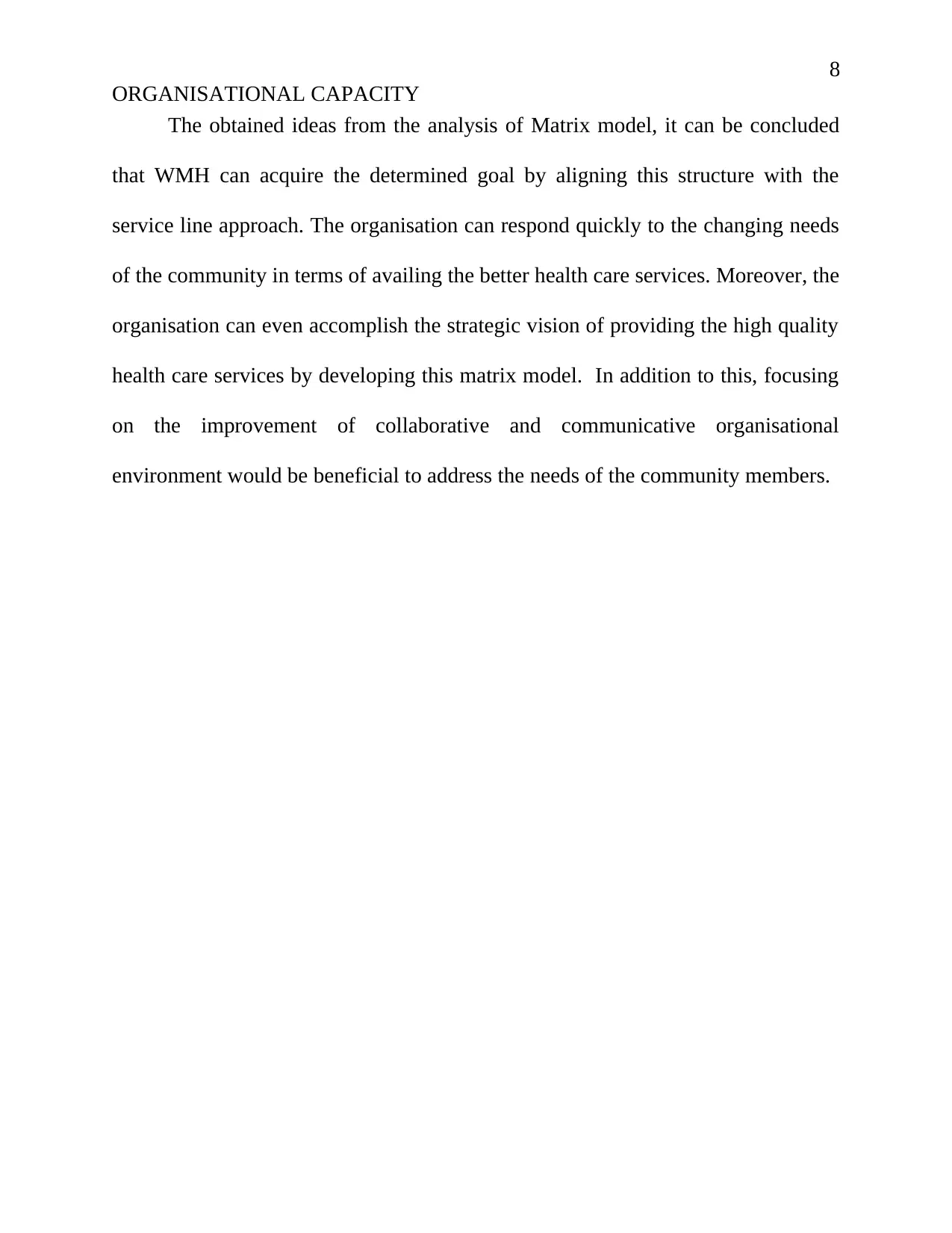
8
ORGANISATIONAL CAPACITY
The obtained ideas from the analysis of Matrix model, it can be concluded
that WMH can acquire the determined goal by aligning this structure with the
service line approach. The organisation can respond quickly to the changing needs
of the community in terms of availing the better health care services. Moreover, the
organisation can even accomplish the strategic vision of providing the high quality
health care services by developing this matrix model. In addition to this, focusing
on the improvement of collaborative and communicative organisational
environment would be beneficial to address the needs of the community members.
ORGANISATIONAL CAPACITY
The obtained ideas from the analysis of Matrix model, it can be concluded
that WMH can acquire the determined goal by aligning this structure with the
service line approach. The organisation can respond quickly to the changing needs
of the community in terms of availing the better health care services. Moreover, the
organisation can even accomplish the strategic vision of providing the high quality
health care services by developing this matrix model. In addition to this, focusing
on the improvement of collaborative and communicative organisational
environment would be beneficial to address the needs of the community members.
⊘ This is a preview!⊘
Do you want full access?
Subscribe today to unlock all pages.

Trusted by 1+ million students worldwide
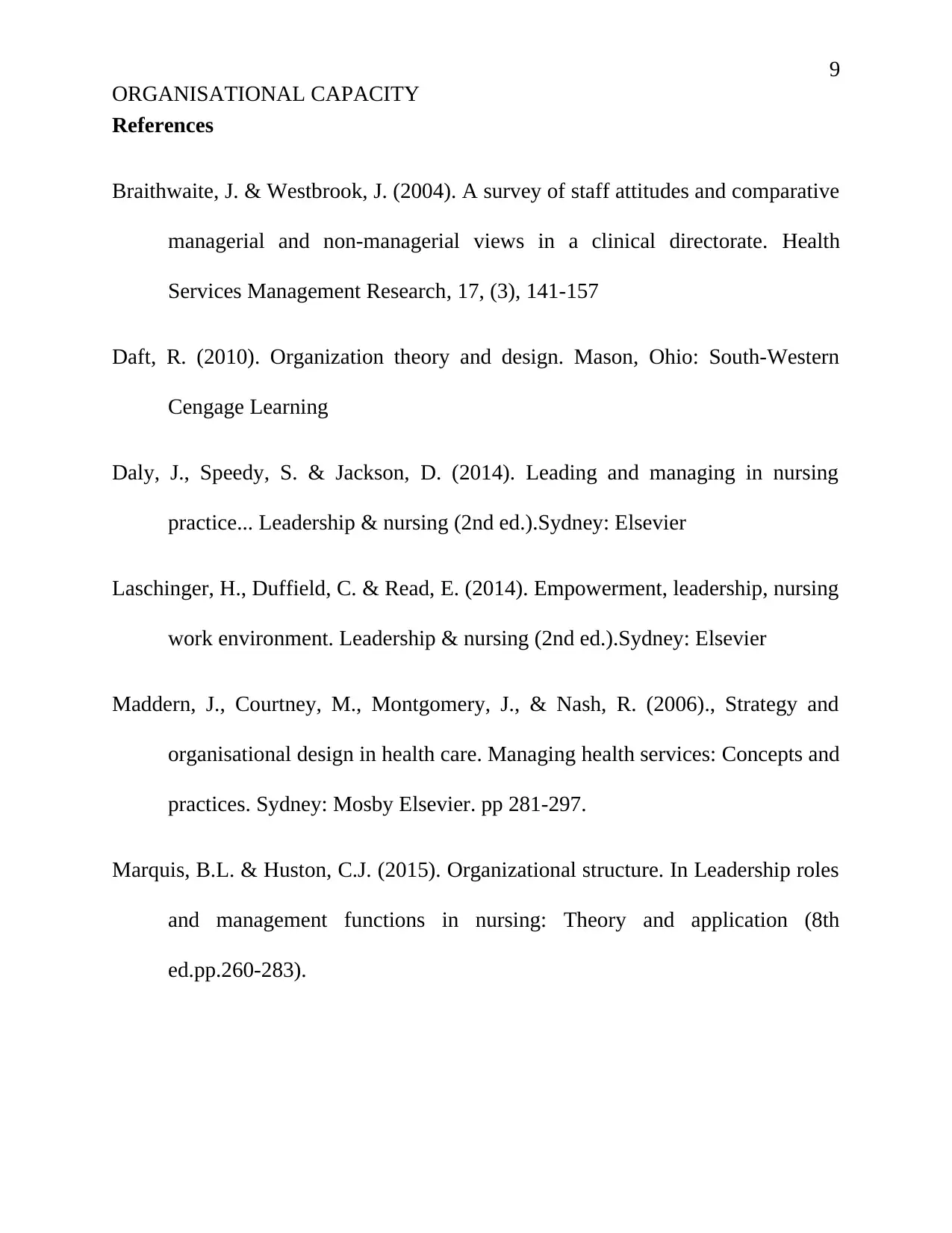
9
ORGANISATIONAL CAPACITY
References
Braithwaite, J. & Westbrook, J. (2004). A survey of staff attitudes and comparative
managerial and non-managerial views in a clinical directorate. Health
Services Management Research, 17, (3), 141-157
Daft, R. (2010). Organization theory and design. Mason, Ohio: South-Western
Cengage Learning
Daly, J., Speedy, S. & Jackson, D. (2014). Leading and managing in nursing
practice... Leadership & nursing (2nd ed.).Sydney: Elsevier
Laschinger, H., Duffield, C. & Read, E. (2014). Empowerment, leadership, nursing
work environment. Leadership & nursing (2nd ed.).Sydney: Elsevier
Maddern, J., Courtney, M., Montgomery, J., & Nash, R. (2006)., Strategy and
organisational design in health care. Managing health services: Concepts and
practices. Sydney: Mosby Elsevier. pp 281-297.
Marquis, B.L. & Huston, C.J. (2015). Organizational structure. In Leadership roles
and management functions in nursing: Theory and application (8th
ed.pp.260-283).
ORGANISATIONAL CAPACITY
References
Braithwaite, J. & Westbrook, J. (2004). A survey of staff attitudes and comparative
managerial and non-managerial views in a clinical directorate. Health
Services Management Research, 17, (3), 141-157
Daft, R. (2010). Organization theory and design. Mason, Ohio: South-Western
Cengage Learning
Daly, J., Speedy, S. & Jackson, D. (2014). Leading and managing in nursing
practice... Leadership & nursing (2nd ed.).Sydney: Elsevier
Laschinger, H., Duffield, C. & Read, E. (2014). Empowerment, leadership, nursing
work environment. Leadership & nursing (2nd ed.).Sydney: Elsevier
Maddern, J., Courtney, M., Montgomery, J., & Nash, R. (2006)., Strategy and
organisational design in health care. Managing health services: Concepts and
practices. Sydney: Mosby Elsevier. pp 281-297.
Marquis, B.L. & Huston, C.J. (2015). Organizational structure. In Leadership roles
and management functions in nursing: Theory and application (8th
ed.pp.260-283).
Paraphrase This Document
Need a fresh take? Get an instant paraphrase of this document with our AI Paraphraser
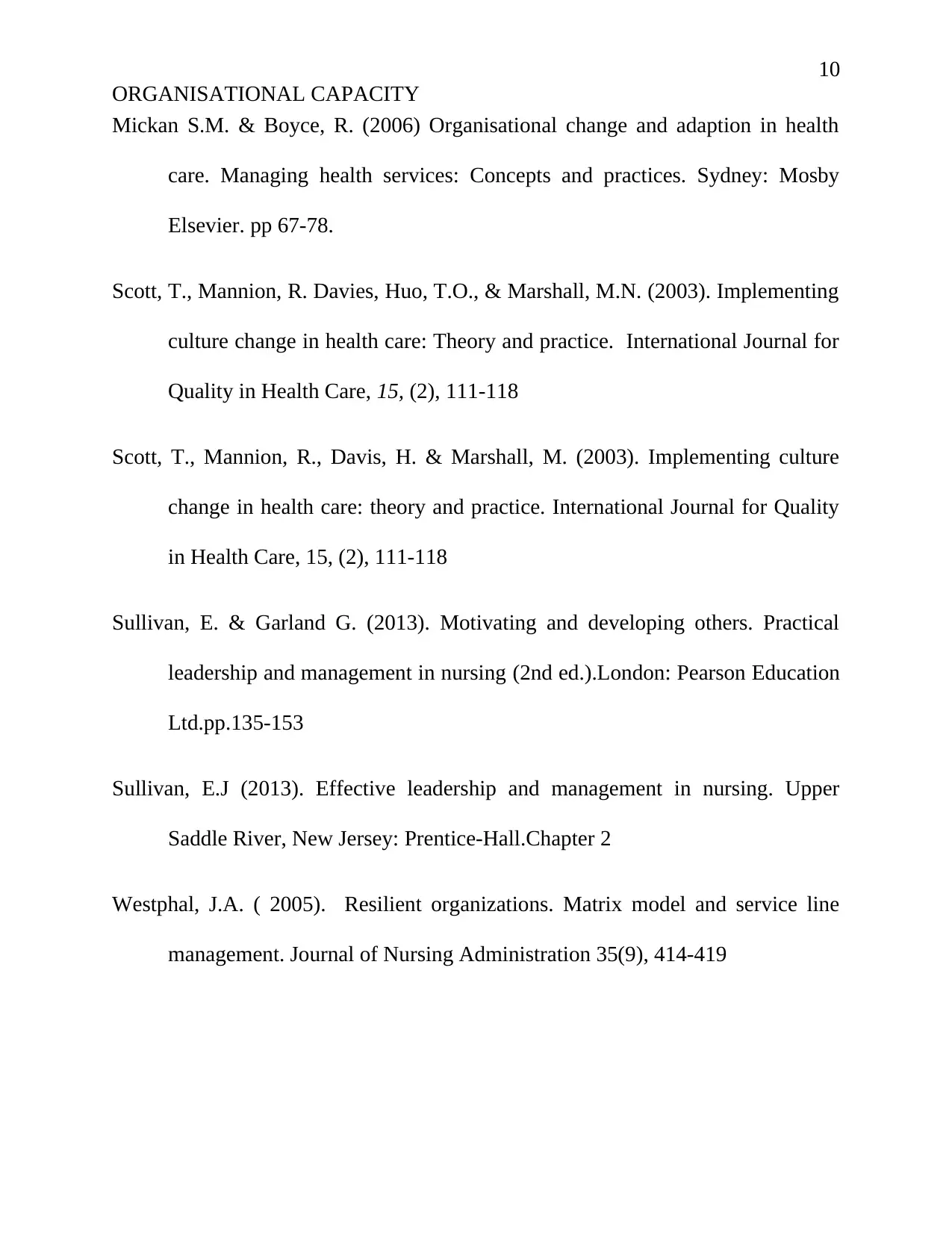
10
ORGANISATIONAL CAPACITY
Mickan S.M. & Boyce, R. (2006) Organisational change and adaption in health
care. Managing health services: Concepts and practices. Sydney: Mosby
Elsevier. pp 67-78.
Scott, T., Mannion, R. Davies, Huo, T.O., & Marshall, M.N. (2003). Implementing
culture change in health care: Theory and practice. International Journal for
Quality in Health Care, 15, (2), 111-118
Scott, T., Mannion, R., Davis, H. & Marshall, M. (2003). Implementing culture
change in health care: theory and practice. International Journal for Quality
in Health Care, 15, (2), 111-118
Sullivan, E. & Garland G. (2013). Motivating and developing others. Practical
leadership and management in nursing (2nd ed.).London: Pearson Education
Ltd.pp.135-153
Sullivan, E.J (2013). Effective leadership and management in nursing. Upper
Saddle River, New Jersey: Prentice-Hall.Chapter 2
Westphal, J.A. ( 2005). Resilient organizations. Matrix model and service line
management. Journal of Nursing Administration 35(9), 414-419
ORGANISATIONAL CAPACITY
Mickan S.M. & Boyce, R. (2006) Organisational change and adaption in health
care. Managing health services: Concepts and practices. Sydney: Mosby
Elsevier. pp 67-78.
Scott, T., Mannion, R. Davies, Huo, T.O., & Marshall, M.N. (2003). Implementing
culture change in health care: Theory and practice. International Journal for
Quality in Health Care, 15, (2), 111-118
Scott, T., Mannion, R., Davis, H. & Marshall, M. (2003). Implementing culture
change in health care: theory and practice. International Journal for Quality
in Health Care, 15, (2), 111-118
Sullivan, E. & Garland G. (2013). Motivating and developing others. Practical
leadership and management in nursing (2nd ed.).London: Pearson Education
Ltd.pp.135-153
Sullivan, E.J (2013). Effective leadership and management in nursing. Upper
Saddle River, New Jersey: Prentice-Hall.Chapter 2
Westphal, J.A. ( 2005). Resilient organizations. Matrix model and service line
management. Journal of Nursing Administration 35(9), 414-419
1 out of 11
Related Documents
Your All-in-One AI-Powered Toolkit for Academic Success.
+13062052269
info@desklib.com
Available 24*7 on WhatsApp / Email
![[object Object]](/_next/static/media/star-bottom.7253800d.svg)
Unlock your academic potential
Copyright © 2020–2025 A2Z Services. All Rights Reserved. Developed and managed by ZUCOL.





